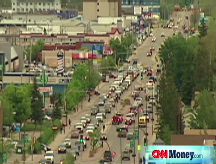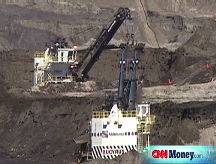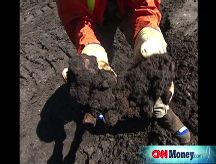Awash in oil money, and problems
Energy Hunt: Fort McMurray was a sleepy town on the Canadian frontier until oil transformed it into a boomtown with tons of opportunities - and concerns.
FORT MCMURRAY, Alberta (CNN) -- On a hot summer day, there's a distinct smell around the remote, northern town of Fort McMurray, Canada. You might think it's the oil being processed at nearby plants. But most residents will tell you it's the smell of money.
Most Americans probably don't know that one third of the world's known oil deposits are buried in the dirt of Canada's Alberta province. The Oil Sands of Canada - as they are known - contain the largest known oil deposit in the world, significantly larger than that of Saudi Arabia. One and a half million barrels of oil are extracted from the land every day, most of it sent directly to the U.S.
Alberta supplies about ten percent of America's imported oil - some of it from conventional wells, but a growing amount from Oil Sands. And the fast-growing industry has turned the town of Ft. McMurray into a bonafide "boomtown" with folks here juggling new riches - and new problems.
Money pouring into the town allows residents to enjoy the highest per capita income in Canada. Even low-end service jobs, like flipping burgers, waiting tables, or pumping gas, pay upward of $15 an hour.
The nearest cities, Edmonton and Calgary, are both facing labor shortages as unskilled workers migrate north for better pay. Some even refer to the town as "Fort McMoney."
"You can say all the bad things you want about this town," challenged Jesse Brether, a Ft. McMurray Oil Sands worker. "You know what? For fifty dollars an hour, I'll deal with it... I'm making over a hundred thousand dollars a year, and I'm twenty-two!"
Despite the opportunities found here, there are plenty of bad things to say about the town (including the fact that my crew and I made for some great eating for the angriest mosquitoes and black flies we've ever encountered).
Traffic, for one, is disastrous. The infrastructure hasn't kept pace with the need for workers, so this town of less than 100,000 residents has traffic jams that would shame a city ten times the size.
Housing development hasn't kept up, either. The median cost of a single family home, at just a little under $700,000, is the highest in Canada, and about the same as San Francisco. Just buying a little plot of land and dropping a mobile home on it will set you back almost half a million bucks, and paying $2,000 to rent a one-bedroom apartment is considered a deal.
Besides the infrastructure problems there are growing environmental concerns that have come about as the Oil Sands industry grows.
Native Canadian groups who once thrived on the area's abundant natural resources are worried. While jobs have been created, and contracts have been awarded to native small businesses, the gains are overshadowed by reports of deformed fish and discolored meat in the wildlife. A local health board study found unusually high rates of cancers and other illness, although both the Alberta government and the oil companies dispute those claims.
But it's hard to dispute the area's vast deforestation as the Oil Sands have become the largest construction zone on earth. The huge swath of boreal - or coniferous - forest that has been removed is clearly visible from space, and locals worry about the long term ecological effect of the clear-cutting.
"I call the Boreal forest the lungs of the earth," says former Chief Robert Cree. "If the Boreal Forest is just depleted to a point, then what's going to happen?"
Turning Oil Sand into usable energy is an arduous, resource intensive process. Oil sand is mined in giant pits, then the oil has to be separated from the sand. To do this, Oil Sand is washed with warm water, a process that uses large quantities of natural gas. Once the sand and the oil are separated, the oil must be further processed into a lighter form of crude that can be easily refined into gasoline, diesel and heating oil.
Critics claim that the extra step of "upgrading" the viscous, molasses-like oil into usable crude emits three times as much carbon dioxide as drilling for and transporting conventional oil. While the industry calls that number is inflated, Shell, one of the major operators in the area, puts that figure at around 200%.
And then there's the water. Taken from a local river and used to wash the oil from the sands the water is left to evaporate in huge, lined ponds. The ponds are required by law to prevent contaminated water from leaking back into the water table.
After the water evaporates, it leaves fine sand, and a vast, devastated landscape that would be an ideal setting for the opening scene of a Star Wars remake.
Companies are required, by law, to replant the land they displace, but the reclamation process can take up to fifty years.
The ecological repercussions are worrying more than just the locals. A number of major US mayors are urging cities across the nation to ban the use of gas made from oil sands in municipal vehicles, although tracing gasoline to its origin is a near impossibility.
As worldwide demand for oil grows and the search for new sources picks up speed, it's unclear whether concerns about environmental damage will overcome the desire on the part of American policy makers for more oil from friendly, stable countries like Canada.
Canada has long produced more oil than it needs, and most of the excess is piped directly into the U.S. There's no pipeline yet to the West Coast of Canada, but there is a proposal to build one, and it's backed by the Chinese. If that pipeline gets built, oil could just as easily be shipped to China, leaving less for the US.
Assuming oil prices stay above $50 a barrel, Canada can optimistically increase its daily Oil Sands output from 1.5 million barrels per day today, to four or even five million barrels per day within a decade.
Either way, Canada's influence in the global energy market is set to grow as fast as the once sleepy little boom town of Ft. McMurray. ![]()





